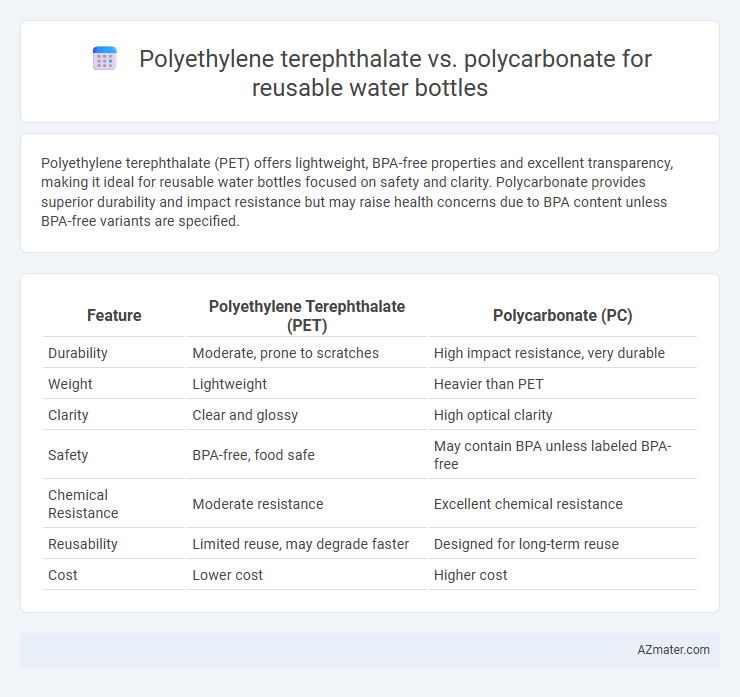Polyethylene terephthalate (PET) offers lightweight, BPA-free properties and excellent transparency, making it ideal for reusable water bottles focused on safety and clarity. Polycarbonate provides superior durability and impact resistance but may raise health concerns due to BPA content unless BPA-free variants are specified.
Table of Comparison
| Feature | Polyethylene Terephthalate (PET) | Polycarbonate (PC) |
|---|---|---|
| Durability | Moderate, prone to scratches | High impact resistance, very durable |
| Weight | Lightweight | Heavier than PET |
| Clarity | Clear and glossy | High optical clarity |
| Safety | BPA-free, food safe | May contain BPA unless labeled BPA-free |
| Chemical Resistance | Moderate resistance | Excellent chemical resistance |
| Reusability | Limited reuse, may degrade faster | Designed for long-term reuse |
| Cost | Lower cost | Higher cost |
Introduction: Understanding Reusable Water Bottle Materials
Polyethylene terephthalate (PET) and polycarbonate (PC) are widely used materials for reusable water bottles, each offering distinct advantages in durability and safety. PET is lightweight, BPA-free, and highly recyclable, making it a popular choice for eco-conscious consumers. Polycarbonate provides superior impact resistance and clarity but may contain BPA unless specifically manufactured as BPA-free, influencing its suitability for health-focused users.
What is Polyethylene Terephthalate (PET)?
Polyethylene terephthalate (PET) is a durable, lightweight thermoplastic polymer widely used in reusable water bottles due to its excellent strength-to-weight ratio and resistance to impact. PET offers excellent clarity, making bottles transparent and visually appealing while maintaining high resistance to moisture and chemicals, ensuring safe storage of beverages. Its recyclability and relatively low production cost make PET an environmentally favorable choice compared to other plastics like polycarbonate.
What is Polycarbonate (PC)?
Polycarbonate (PC) is a durable, transparent thermoplastic polymer commonly used in reusable water bottles due to its high impact resistance and heat tolerance. Unlike polyethylene terephthalate (PET), polycarbonate offers superior strength and clarity, making it less prone to cracking or breaking during regular use. Polycarbonate bottles are often BPA-free, providing a safer alternative for repeated hydration without compromising structural integrity.
Chemical Composition and Structure Comparison
Polyethylene terephthalate (PET) consists of repeating units of terephthalic acid and ethylene glycol forming a linear polyester structure, offering high tensile strength and chemical resistance. Polycarbonate (PC) is composed of bisphenol A and phosgene, creating a tough, amorphous polymer with superior impact resistance and thermal stability. The molecular arrangement of PET provides rigidity but lower impact toughness compared to the amorphous, more flexible network structure of polycarbonate, influencing durability and safety in reusable water bottles.
Durability and Impact Resistance
Polycarbonate demonstrates superior durability and impact resistance compared to polyethylene terephthalate (PET), making it ideal for reusable water bottles subjected to frequent drops and rough handling. PET is lightweight and cost-effective but tends to crack or deform under high stress, whereas polycarbonate maintains structural integrity and resists shattering. The enhanced toughness of polycarbonate also contributes to longer lifespan and better performance in demanding environments.
Safety and Health Considerations (BPA, Leaching, etc.)
Polyethylene terephthalate (PET) is BPA-free and generally considered safe for single-use water bottles but may degrade and leach antimony and other chemicals when reused or exposed to heat. Polycarbonate contains BPA, which can leach into liquids over time and raise health concerns related to hormonal disruption. For reusable water bottles, BPA-free alternatives like Tritan or stainless steel are often recommended to ensure safety and minimize chemical exposure.
Environmental Impact and Recyclability
Polyethylene terephthalate (PET) offers high recyclability with well-established global recycling streams, significantly reducing environmental impact when processed correctly. Polycarbonate (PC), while durable and BPA-free alternatives exist, poses challenges due to lower recycling rates and potential release of bisphenol-A (BPA), raising environmental and health concerns. Choosing PET reusable water bottles supports circular economy goals with reduced carbon footprint compared to polycarbonate counterparts.
Weight, Design, and Aesthetic Differences
Polyethylene terephthalate (PET) is lightweight and offers greater flexibility in molding, making it ideal for slim, portable reusable water bottles with a smooth surface finish. Polycarbonate (PC), while heavier, provides superior durability and impact resistance, allowing for more complex, rigid designs with clear, glossy aesthetics. The choice between PET and PC often balances the trade-off between PET's lightweight convenience and PC's robust, premium look and feel.
Cost Effectiveness and Market Availability
Polyethylene terephthalate (PET) offers superior cost effectiveness for reusable water bottles due to its lower raw material and production expenses compared to polycarbonate (PC). PET's widespread market availability and established recycling infrastructure further reduce overall costs and environmental impact, making it the preferred material for mass-produced bottles. Polycarbonate, while more durable and heat resistant, incurs higher manufacturing costs and limited recycling options, restricting its market presence and affordability for everyday reusable water bottles.
Choosing the Best Material for Your Reusable Water Bottle
Polyethylene terephthalate (PET) offers lightweight durability and excellent resistance to impact and chemicals, making it a popular choice for reusable water bottles with cost-efficiency and recyclability. Polycarbonate (PC) provides superior strength, high transparency, and heat resistance, suitable for bottles designed for frequent use and dishwasher safety, but concerns about BPA content influence consumer preference. Evaluating factors such as material safety, durability, environmental impact, and user lifestyle is essential to choose between PET and polycarbonate for optimal reusable water bottle performance.

Infographic: Polyethylene terephthalate vs Polycarbonate for Reusable Water Bottle
 azmater.com
azmater.com